Handling editor: Phanikrishna Thota
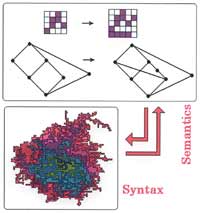 |
Nonlinear Sciences Group
at Kobe University
|
by Tamiki Komatsuzaki,
Department of Earth and Planetary Sciences,
Kobe
University.
The nonlinear sciences group at Kobe University was
founded in the late 1970s. This is the first and unique nonlinear
sciences group in a Department of Earth and Planetary Sciences in
Japan. From the 1970s, as one of the centers of nonlinear sciences in
Japan, about eight professors and more than 30 PhD students have
organized, amplified and developed new fields of nonlinear sciences
involving emergent behavior, fractals, cognition, economy, chemical and
biological physics. Most of the PhD students have continued their
researches in academic research positions at universities and national
institutes. Now there are two professors, three postdocs (from the
University of Texas at Austin, the University of Chicago, and Nagoya
University), and fifteen PhD students (nine of them from other
universities and three from other departments (physics, biology and
agriculture) at Kobe University), five MSc students (one from the US)
and four BS students.
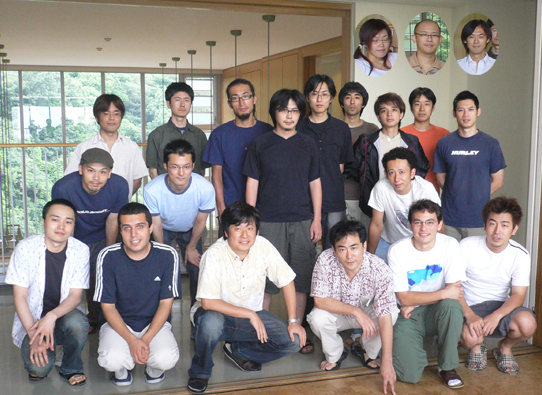 |
|
Students, postdocs, and staff in summer
2006
insets from left: Yuka Tauchi, Soichiro Tsuda, Moto Kamiura;
standing from left: Akira Fukano, Junichiro Wakatsuki, Shinpei
Tatsumi, Hiroyuki Ohta, Tomohiro Shirakawa, Kazuto Sei, Asaki
Nishikawa, Satoshi Noda, Chun-Biu Li;
half-rising posture from left: Sohei Wakisaka, Taichi Haruna, Fumihiro
Matsuura;
front from left: Yasuhiro Matsunaga, Mustafa Demirplak, Tamiki
Komatsuzaki, Yukio-Pegio Gunji, Eugene Schneider Kitamura, Daisuke
Uragami. |
Main research interests of the current members are
the establishment of a new mathematical framework for describing
regularity buried in chaos in changes of the state, emergent behavior,
and robustness of the occurrence (e.g., functions of biological
systems) in complex systems. The mathematical tools on which our
current research is based range from dynamical system theory (normal
form, normally hyperbolic invariant manifolds, bifurcation theory,
embedology), information theory (computational mechanics) to internal
measurement/endo-physics (sheaf, lattice, category, group theory). The
focus research projects are:
- Biological Organization
in Internal Perspective
(Yukio-Pegio Gunji)
The organization of living things is characterized
by dynamical hierarchical structures inheriting discrepancy among
levels. It can be expressed as a system consisting of two layers; the
microscopic perspective (Extent) defined by a collection of elements
and the macroscopic perspective (Intent) defined by the property as a
whole, and the interplay between them. First we show that if the
microscopic and macroscopic perspectives are consistent with each
other (an ideal case), then the operation between the two layers can
be expressed as a sheaf between a lattice and a quotient lattice,
where a sheaf is a mathematical operation representing the gluing
process. Second, we introduce an observer who cannot look out over the
whole world, and this reveals discrepancy between the two
layers. Third, we introduce a new mathematical construction, called
skeleton, that is derived by the sheaf operation. The skeleton reduces
the discrepancy between the micro- and macroscopic perspectives, which
reveals the perpetual transition between the perspectives. This
process yields a basic framework of biological organizations. Finally,
we argue that the skeleton mediating between the two levels is a
particular expression for the material cause. These ideas are
implemented by using sheaf theory (functor from a topological space to
sets) and a lattice and quotient lattice described with respect to
algebra [1, 9, 12].
- Internal measurement/endo-physics
(Yukio-Pegio Gunji)
The essential feature of the endo-perspective is
examined, and a formal model of the endo-perspective is proposed, by
introducing the mixture of intra- and inter-operations. Because such a
mixture, in its naive realization, entails a paradox within a formal
system, we weaken the inter-operation in order to allow the formal
system to be endowed with that mixture without a contradiction. The
weakened inter-operation is related to the infomorphism proposed by
Barwise. The formal model of the endo-perspective is thereby expressed
as the dynamic infomorphism driven by that mixture. The
endo-perspective is described as a formal system that includes the
outside of the occupied perspective. If such an inclusion is applied
to the common definition of a set, it entails Russel's paradox.
Retaining the outside can be expressed as the mixture of the intent
and the extent of a set together with the mixture of intra-operations
within the intent (or extent) and inter-operations between intent and
extent. The endo-perspective, therefore, consists of two subsystems
corresponding to the intent and the extent, respectively, and is
defined as a system involving a particular mathematical tool (i.e.,
infomorphism) that allows for retaining the outside without a
contradiction. Within that framework, the mixture of the intra- and
the inter-operation drives the dynamical transition of the system, but
it can be terminated by its collapse. This collapse can be predicted
from the internal logic defined within the system. The model is
constructed through the verification of `a weakened paradox'. Because
the definition of the system involves a weakened paradox only, it does
not always lead to a contradiction, although the collapse of the
system corresponds to a contradiction. The double standards can be
embedded into the system via a domain with truth-values (the inside)
and a domain in which the collapse of the logic can occur (the
outside) [4, 7, 10, 11].
- Biologically motivated computing (slime-mold computing)
(Yukio-Pegio Gunji)
|
Although there are many attempts
for emergent computing based on biological molecular devices (local
non-linear dynamics, DNA-based, protein-based and amorphous
computing), the notion of emergent computing is still ambiguous.
Emergence and 'error' are both sides of the same coin. A biologically
based computer could be an unstable machine, while it would have the
potential for emergent computing. Clearly, not the error but the
emergent computing is based on the relationship of trust between a
user and a machine.
|
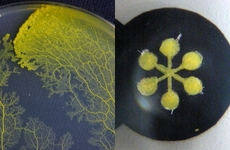 |
|
To manifest that
aspect we implement Boolean gate as a biological device made of slime
mold. The emergent computation is theoretically defined by the global
coherence generated from local interactions, while that coherence
cannot be predicted locally. It needs discrepancies between local and
global mechanisms. To introduce those discrepancies we use a real,
living slime mold, Physarum polycephalum as a computing
device. Compared with DNA and/or proteins used in computing that are
non-living things, living slime mold has living wholeness that cannot
be predicted locally. That is why discrepancies between local
interactions and living unity as a whole can be employed to emergent
computing [3, 5, 8].
|
| Physarum
polycephalum grown on the agar gel plate (left); a device of
plasmodium on a dry negative mask on a moist agar surface connected
to a robot through optical interfaces
(right). |
- Cognitive Systems / Consciousness
(Yukio-Pegio Gunji)
Psychologists previously proposed introspection:
The perception of a red apple is based on a label of the red apple.
Such an idea falls into infinite regression and/or a self-reference
because it leads to the mixture of a label and referring to a label.
In spite of the collapse of the introspectionism, the notion of qualia
was recently proposed, and it brings us another concept different from
types. On the one hand, introspection was prescribed as a kind of
type, that is, why it is a particular abstract expression and/or ideal
form. Then it is destined to be a self reference. On the other hand,
qualia appear in the science of consciousness as tokens, individual
things that exist in a universe in their own right. Brain scientists
and philosophers of consciousness claim that brain computes or
constructs not types but tokens that are qualia. If one separates real
universe from formal universe, or description from what is to be
described, then one is destined to take after the difficulty resulting
from the discrepancies between real things and introspection. One has
to claim that real things (tokens) cannot be described or cannot be
expressed as types. Hence, the proposal of qualia has a new
significance against introspection. Therefore, the qualia are destined
to be hard-problems. We have to focus on the co-existence of
types-computation and tokens-computation. It is easy to see that
type-computation in a machine must be accompanied with materialistic
phenomena (i.e., tokens-computation) as electric flow, adequate
temperature and so on. Especially in a brain, type-computation (a
particular computation in a particular area of a brain) is carried out
with token-computation (surrounding activities in and out of a
brain). There is no static duality between types- and
tokens-computations. Even if one attempts to describe a consistent
model using both types- and tokens-computations, tokens-computation
must be cut off with a finite domain. As a result, computation
co-existing with its own environment by which a computation is carried
out must be expressed as a dynamical duality enhanced in phenomenal
computing. The notion of dynamical duality is a key concept breaking
through the notion of hard problems in the science of consciousness.
In our lab, cognitive experiments and models in which consciousness
are grasped as dynamical duality between types- and
tokens-computations are conducted and proposed [2,
6].
- Dynamical Origin of Chemical Reactions
(Tamiki Komatsuzaki)
|
Chemical reactions are regarded as
the most elementary prototype of `change' of the states or matter. How
a rearrangement of atoms or molecules constituting a system occurs is
one of the most intriguing fundamental questions from the day of
alchemy. However why can the system react from reactants to the
products? In other words, in the figure below, what origin
differentiates the initial conditions which bring the system to the
product (gray colored trajectory) or not (red colored trajectory)?
Recently we revealed [13-15]
that normally hyperbolic invariant manifolds (NHIMs) and the stable
and unstable invariant manifolds survive even in a sea of chaos, and
this can provide a regularized reaction pathway to mediate chemical
reaction in the `stochastic' process of an n-particle
system.
|
|
Most chemical reaction
theories in condensed phase divide the wholeness into the
reacting system (part) and the residuals, which has been
regarded as a heat bath. The chemical reactions are then
regarded as being governed by `casting dice'. However, our findings
indicate that nature may have, at least locally, known a priori
the destination of chaotic reaction dynamics [17]. The stability and bifurcation of the NHIMs [20] are thus the most essential subjects in
understanding "who knows the goal of the reaction" and
"what the whole and parts are in the change of the
state."
|
|
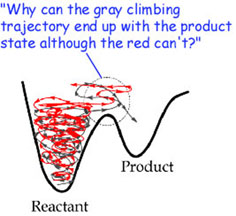 |
- Single-molecule time series analysis: Dynamical Hierarchy,
Molecular Memory, Non-Ergodicity, Abnormal Diffusion
(Tamiki Komatsuzaki)
|
The question "How can one learn from
single-molecule time series about the underlying multi-dimensional
free-energy landscape or state space?" is one of the most
important and central subjects in biological research. In order to
explore the mechanism of fast protein folding in competition with
thermal fluctuations in a single molecule level, we focus on the
following four subjects:
|
- Construction of the underlying state space structure and/or an
effective free-energy landscape from single-molecule time series;
- Noise reduction to extract symbolic sequences of state-to-state
transitions buried in experimental noise of single-molecule time series;
- Extraction of the underlying hierarchical dynamical structures and
their mutual information flow from singlemolecule time series;
- Exploration of the geometrical structure of the high-dimensional
state space from single-molecule time series.
|
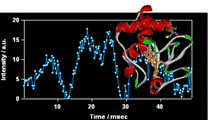 |
|
We have been
developing a new dynamical platform of nonlinear time series analysis
by mixing the modern techniques of embedology (Wavelet-based
embedology), information theory (computational mechanics), and
dynamical system theory (finite size Liapunov exponent, epsilon-tau
entropy). This project is supported by Japan Science and Technology
Cooperation as a five-year project (2004-2009) with experimentalists
in other institutes.
|
| How can one learn
from single-molecule time series about the underlying
multi-dimensional free-energy landscape or state
space? |
- Complexity of Protein Landscape and Dynamics: toward Molecular
Sociology
(Tamiki Komatsuzaki)
Why can natural proteins find their unique native
state among the candidates of states, whose number is estimated to be
beyond the age of the universe? The key concept of protein folding
problem has been interpreted as the `design' of the protein landscapes
that the protein might have acquired via mutations. Natural (small)
proteins are believed to be designed as having a funnel-like energy
landscape introducing a strong energy bias toward the global minimum.
However, how can one quantify the degree of funnel-like or ruggedness
in terms of the underlying multi-dimensional energy landscape? What is
the environment for protein in solutions, cells, or organisms?
Can we put all the effect of the environment, e.g., water molecules in
the vicinity of protein molecules, into the thermal bath and the
friction source? We have been developing a new platform to resolve the
important contemporary issues in complexity of protein landscape [19] and dynamics [16, 18] in solution in terms of several advanced
techniques in data mining (principal component analysis), information
theory, network theory and fluid mechanics (water vector field
analysis, Lagrangian coherent structure). The goal of this project is
to establish the undistinguishable, itinerant behavior among the
dynamically moving `system' and the `bath' and its role for
function occurring robustly in the thermal fluctuations.
We have also organized (or we have been involved in
the organization of) many multidisciplinary conferences:
- Geometrical Structures of Phase Space in
Multi-Dimensional Chaos: Applications to Chemical Reaction Dynamics in
Complex Systems, Kyoto, October 26-November 1, 2003.
- Cross-Talk between Chemistry and Planetary Sciences, Kobe,
November 17, 2004
- Dynamical Foundation of Functions and Energy Transfer in Protein
Systems, Chicago , November 1-6, 2004, and Sapporo, November 26-28,
2005.
Recently, one of the staff edited a book entitled
Geometric Structures of Phase Space in Multi-Dimensional Chaos:
Applications to Chemical Reaction Dynamics in Complex Systems as a
special volume of Advances in Chemical Physics, 1224 pages, John-Wiley
& Sons, Inc. New York (2005). This book includes several reviews,
for example, of recent developments concerning regularity buried in
chaos in chemical reactions and celestial mechanics in terms of
normally hyperbolic invariant manifolds in high-dimensional phase
space.
Kobe is located between the sea and the Rokko
mountain range. Kobe has been an important port city for many
centuries as one of the first Japanese ports to be opened to foreign
trade in the 1800s and it is one of Japan's most cosmopolitan cities.
Every year we have foreign visitors working on several multidisciplinary
researches (robotics, chemical and biological physics, single-molecule
measurement, celestial mechanics, molecular informatics) and conduct
long-term collaborative research with foreign research groups in the
USA, Germany, UK, France and other countries. The current staff have
been appointed as adjunct professors in other institutes and presented
a set of tutorial lectures of their research in departments of
mathematics, chemistry, physics, philosophy, sociology, and so forth,
in more than nine universities (University of Tokyo, 1994, 1999, 2003;
Tohoku University, 1995; Hokkaido University, 1996; Osaka University,
1997; Niigata University, 1998; Nagoya University, 2002; Waseda
University, 2002; Ibaraki University, 2004; Hiroshima University,
2006).
Applicants to PhD programs in nonlinear sciences
group at Department of Earth and Planetary Sciences, Kobe University,
will be nominated for RA fellowships by the
Graduate School of Science and Technology or COE RA
fellowships by a 21st Century Center of Excellence (COE) Program
Origin and Evolution of Planetary Systems. They are also
encouraged to apply for funding via
JSPS Postdoctoral Fellowship that are available
every year.
Selected Publications (2001-2006)
| 1. |
Gunji, Y.-P. & Higashi, H. (2001)
The origin of universality: making and invalidating free
category. Physica D 156: 283-313. |
| 2. |
Gunji, Y.-P., Aono, M., Higashi,
H. & Takachi, Y. (2001) The third wholeness as an
endo-observer. In: Science of Interface (Diebner, H.H.,
Druckrey, T. & Weibel, P., eds.), Genista verlag, Tubingen,
pp. 111-130. |
| 3. |
Takachi, Y. & Gunji, P.Y.,
(2003). Punctuated Equilibrium in Thoroughbred Evolution and its Model
based on Asynchronous Clocks. Chaos, Solitons & Fractals
19: 555-562. |
| 4. |
Gunji, Y.-P., Takahashi, T. &
Aono, M. (2004) Dynamical infomorphism: form of endo-perspective.
Chaos, Solitons & Fractals 22: 1077-1101. |
| 5. |
Tsuda, S. Aono, M. & Gunji,
Y.-P. (2004) Robust and emergent Physarum-computing.
BioSystems 73: 45-55. |
| 6. |
Nabeshima, T. & Gunji,
Y.-P. (2004) Zipf's law in phonograms and Wreibull distribution in
ideograms: comparison of English with Japanese. BioSystems
73: 131-139. |
| 7. |
Gunji, Y.-P. & Kamiura,
M. (2004) Observational heterarchy enhancing active coupling.
Physica D 198: 74-105. |
| 8. |
Tsuda, S., Zauner, K. P. & Gunji,
Y. P. (2005) Robot Control with Biological Cells. In Proceedings
of Sixth International Workshop on Information Processing in Cells and
Tissues, St. William's College, York, pp.202-216. |
| 9. |
Haruna, T. & Y.-P. Gunji
(2005) Autonomous indefiniteness versus external indefiniteness:
theory of weak topped C-structure and its application to elementary
local cellular automaton. Physica D 202: 71-94. |
| 10. |
Gunji, Y.-P. Miyoshi, H. Takahashi,
T. & Kamiura, M. (2005) Dynamical duality of type- and
token-computation as an abstract brain. Chaos, Solitons &
Fractals 27: 1187-1204. |
| 11. |
M.Kamiura & Y.-P. Gunji (2006)
Robust and Ubiquitous on-off intermittency in active coupling.
Physica D 218: 122-130. |
| 12. |
Gunji, Y.-P. Haruna, T. & Sawa,
K. (2006) Principles of Biological organization: Local-global
negotiation based on "Material cause". Physica D (in
press). |
| 13. |
Komatsuzaki, T. & Berry,
R. S. (2001) Dynamical Hierarchy in Transition States: Why and How
Does a System Climb over the Mountain? Proceedings of National
Academy of Sciences USA 98: 7666-7671. |
| 14. |
Komatsuzaki, T. & Berry,
R. S. (2002) Chemical Reaction Dynamics: Many-Body Chaos and
Regularity. Advances in Chemical Physics 123 (Prigogine,
I., Rice, S.A. eds.) John Wiley & Sons, Inc. New York,
pp. 79-152. |
| 15. |
Komatsuzaki, T. & Berry,
R. S. (2002) A Dynamical Propensity Rule of Transitions in Chemical
Reactions. Journal of Physical Chemistry A 106:
10945-10950. |
| 16. |
Matsunaga, Y., Kostov, K. S. &
Komatsuzaki, T. (2002) Multi-Basin Dynamics in Off-Lattice Minimalist
Protein Landscapes. Journal of Physical Chemistry A 106:
10898-10907. |
| 17. |
Komatsuzaki, T. & Berry,
R. S. (2005) Regularity in Chaotic Transitions on Two-Basin
Landscapes. Advances in Chemical Physics 130A (Toda, M.,
Komatsuzaki, T., Konishi, T., Berry, R.S. & Rice, S.A. eds.) John
Wiley & Sons, Inc. New York, pp. 143-170. |
| 18. |
Komatsuzaki, T., Hoshino, K. &
Matsunaga, Y. (2005) Regularity in Chaotic Transitions on Multi-Basin
Landscapes Advances in Chemical Physics 130B (Toda, M.,
Komatsuzaki, T., Konishi, T., Berry, R.S. & Rice, S.A. eds.) John
Wiley & Sons, Inc. New York, pp. 257-313. |
| 19. |
Komatsuzaki, T., Hoshino, K. &
Matsunaga, Y., Rylance, G. J., Johnston, R. L. & Wales,
D. J. (2005) How Many Dimension is Required to Approximate Potential
Energy Landscape of A Model Protein? Journal of Chemical
Physics 122: 084714. |
| 20. |
Li, C.-B., Shojiguchi, A., Toda,
M. & Komatsuzaki, T. (2006) Definability of No-return Transition
States in High Energy Regime Above Threshold Physical Review
Letters 97: 028302-028305. |